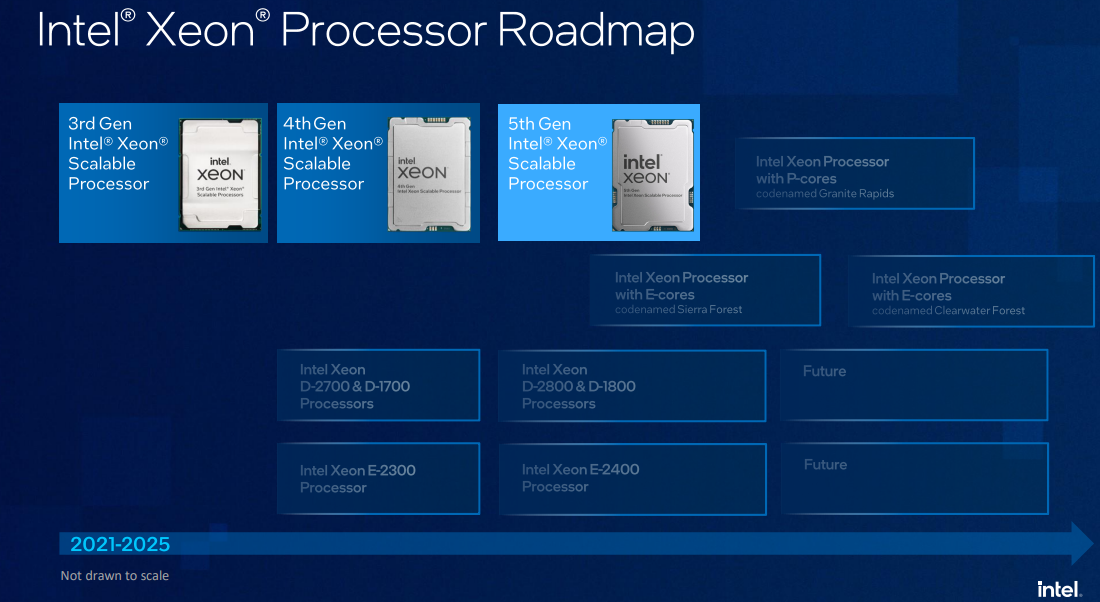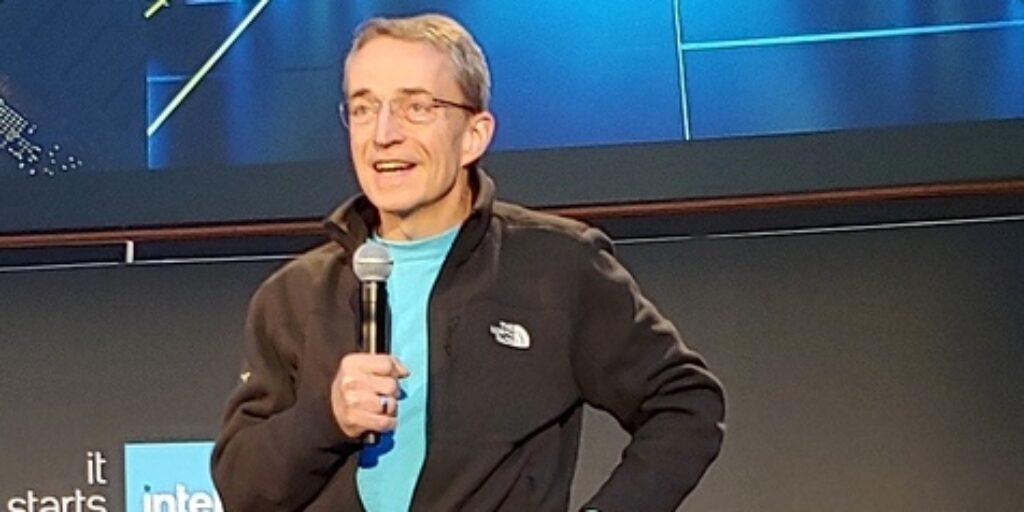At an Intel pre-launch media event earlier this month in Hillsboro, OR, for the new Emerald Rapids data center chip, CEO Pat Gelsinger made a surprise appearance (pictured here) to share his thoughts on the state of Intel. In rapid fire, he covered a range of issues while exuding his characteristic upbeat energy and confidence.
Gelsinger’s comments were as interesting for what he said about the company going forward as they were about recent Intel history. Which is to say: the company in the years leading up to and since his return to Intel in early 2021.
His message: Intel is on a path to regain technological leadership in its struggle for chip supremacy with NVIDIA and AMD, that the days of late and lacking products are over. In fact, while the day-long event focused on the new Xeon chip launched yesterday Gelsinger spent much of his stint on the stage talking about upcoming CPUs and GPUs.
By Gelsinger’s account, those future products are crowding the company’s product roadmap and will be released at a faster cadence than is usual in the microprocessor industry. For Intel OEMs and cloud services provider customers, this presents something of a quandary for those who’d prefer their Intel products to have a longer shelf-life. But Gelsinger said the aggressive roadmap is key to winning back market trust lost in the five or six years preceding 2021.
“We’ve earned their (the market’s) distrust,” he said. “We missed schedules, we didn’t give them enough product, and they were poor quality and they weren’t competitive. OK, so now we’re swinging to rebuilding their trust and confidence. …everyone says, ‘We want Intel back, we want you to win, but you gave us crappy products and not enough of them.’”

Over the past 12-18 months, Gelsinger contended, Intel has moved the trust needle forward. “But now we’ve got to go win. I’ve got to win sockets back from AMD…. We’ve got to show up aggressively, we lost those designs, now we have to go win them.”
He conceded that not all Intel customers are happy with the rapid release schedule of the company’s projected roadmap. A reporter asked Gelsinger about the wisdom of releasing the 64-core 5th Gen Xeon Emerald Rapids now, having announced in September that the 288-care Sierra Forest CPU will roll out in mid-2024 – while the 4th Gen Sapphire Rapids product was released only earlier this year. But Gelsinger said the products are based on the Sapphire Rapids platform, making it easy for Intel OEMs to incorporate the new products as they are released.
“Part of it is really just the ability to take your Sapphire Rapids platform and drop a better part into it, and just continue that momentum,” he said. “And it’s just about a product, right? When you think about Emerald Rapids, with more cores, better caching hierarchy, better power, performance, better TCO, benefits like that, it’s a no brainer. If you’re shipping one Sapphire Rapids you should be looking at adding Emerald Rapids into that portfolio. And that’s straightforward. So from that perspective it’s not a hard sell.”
To customers who object that they won’t “get enough lifetime” from their Emerald Rapids products, Gelsinger presented an argument with an imaginary customer:
Gelsinger: Why wouldn’t you ramp a better product?
Customer: But if you’ve got Sierra Forest and Grand Rapids coming soon, that’s a major new platform.
Gelsinger: Right. But are you not going to keep ramping the platform that you have today? No, of course not…
Customer: But you didn’t give me enough time.
Gelsinger: So you want me to go slower with a much better product? Come on, don’t be stupid, right?
“We’re not going to slow down,” Gelsinger said. “We have to get back to unquestioned leadership. And we’re going to do that. That’s going to be a little bit painful for the OEMs because these come in more rapid succession. But getting back to leadership means I’ve got to move faster. If I go slow, I’m not going to get back to leadership. And we’re going to be pushing the OEMs to be pretty aggressive and getting their platforms in place.”
Asked if Intel planned to add an Arm chip to its product line, Gelsinger responded with a firm, “no.” But he also said Intel will manufacture Arm chips as it expands its foundry business even as he poo-pooed Arm as an x86 replacement.
“I expect that I will manufacture an extraordinary amount of Arm products because I’m a foundry,” he said. “We spoke very specifically over the last couple of quarters about the good momentum that we are seeing in the Arm relationship. The (Arm) team, they are selling Intel foundry services for me, I feel like I should put them on commission and quota. …So I believe I will have a significant business, being an Arm foundry provider.”
But “I do not expect that we will build Arm products instead of x86 products as we go forward,” he continued. “That’s the strategy we’re on. And hey, if I lose some sockets to Intel-foundry Arm products, that’s still good for the Intel shareholders.
“As we get our x86 products much more competitive, there’s no reason on the planet that a customer should ever use a Graviton (Arm) instance ever, right? Because with products like Sierra Forest you have the best TCO and you don’t have to port and manage a different software instance on to some other architecture because that’s expensive and hard to qualify multiple software stacks on different architectures. Software developers don’t want to do hard. They want to be innovative and create new capabilities, not hard and long-term work when there is no TCO advantage.”




